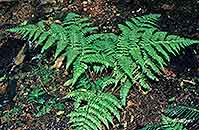Nothoperanema squamiseta (Hook.) Ching
Synonyms |
Dryopteris squamiseta (Hook.) Kuntze |
|---|---|
Common name |
|
Description |
Rhizome erect to suberect, up to 7 mm in diameter (2-4 cm wide and deep?); rhizome scales dark brown, to 10 x 2 mm, lanceolate in outline, margin entire, tapering to a drawn-out point. Fronds tufted, erect to arching, herbaceous, 6-9 per plant. Stipe up to 60 cm long, straw-coloured, reddish-brown near the base, densely set with stiff dark brown scales standing out at right angles to the stipe. Lamina up to 50 × 40 cm, 3-pinnate to 4-pinnatifid on the basiscopically developed basal pinnae, deltate to roughly ovate in outline. Pinnae 10-14 pairs, narrowly oblong-attenuate, spaced apart, almost equally sided. Ultimate lobes oblong, margins weakly lobed or entire, apex lobed or entire, rounded, subglabrous with few brown, upright scales above and below. Rhachis straw-coloured, sparsely set with scales similar to rhizome, but with tuft at junction with pinnae. Sori round, 1-1.4 mm, 12-20 per lobe set in the upper half of the pinnules; indusium kidney-shaped to subcircular, c. 1 mm in diameter, membraneous, margin wavy. |
Notes | Can be distinguished from other Dryopteris-species by having a combination of stiff scales that stand out at right angles on the stipe, entire rounded pinnule lobes and sori that are grouped towards the end of the pinnules. |
Derivation | squama: scale, seta: bristle; refers to the stiff scales on the stipe. |
Habitat | Deep shade in or along streams in evergreen forest, or bamboo forest. |
Distribution worldwide | Africa, Asia, Madagascar and Mascarene Islands. |
Distribution in Africa |
Cameroon, Equatorial Guinea (incl. Bioko), Ethiopia, Kenya, Malawi, Rwanda, Somalia, South Africa, Sudan and South Sudan, Swaziland, Tanzania , Uganda, Zambia, Zimbabwe. |
Growth form |
Lithophytic, terrestrial. |
Literature |
|
